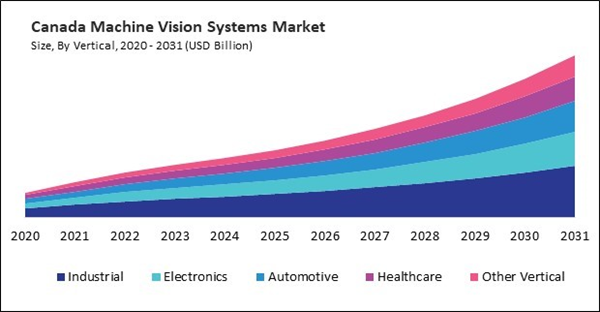The US market dominated the North America Machine Vision Systems Market by country in 2023, and is expected to continue to be a dominant market till 2031; thereby, achieving a market value of $26.32 billion by 2031. The Canada market is experiencing a CAGR of 15.3% during 2024-2031. Additionally, the Mexico market is expected to exhibit a CAGR of 14.4% during 2024-2031.
This market has witnessed substantial growth in recent years, driven by technological advancements, the rise of automation across various industries, and the increasing adoption of artificial intelligence (AI) and machine learning (ML) in production environments. These systems automate industrial applications' visual inspection, measurement, and identification.
These systems are used in various applications across multiple industries, including manufacturing, automotive, healthcare, agriculture, logistics, food and beverage, and electronics. One of the most significant uses of machine vision is in quality control in manufacturing environments. These systems can inspect products quickly, identifying defects, inconsistencies, or deviations from design specifications.
This market in the USA and Canada is experiencing substantial growth, driven by several key factors. These factors include advancements in automation technologies, increasing adoption of Industry 4.0 principles, and robust investments in manufacturing and technology sectors. The U.S. is at the forefront of adopting advanced automation technologies across various industries, including automotive, electronics, and pharmaceuticals. The U.S. manufacturing sector rapidly embraces Industry 4.0, which emphasizes using connected devices, IoT, and AI-driven analytics. MVS plays a crucial role in this transformation by enabling real-time monitoring and data collection on the production floor. In conclusion, the growth of the machine vision systems market in the USA and Canada is propelled by advancements in automation, the adoption of Industry 4.0, robust investments in technology, and demand for high-quality manufacturing.
List of Key Companies Profiled
- Sony Corporation
- Texas Instruments, Inc.
- Baumer Holding AG
- SICK AG
- Canon, Inc.
- Teledyne FLIR LLC
- Intel Corporation
- Omron Corporation
- Denso Corporation
- Microsoft Corporation
Market Report Segmentation
By Component- Smart Camera
- Embedded System
- Lighting
- Frame Grabber
- Other Component
- Flaw Detection
- Verification
- Identification
- Measurement
- Positioning
- Industrial
- Electronics
- Automotive
- Healthcare
- Other Vertical
- 2D
- 3D
- 1D
- US
- Canada
- Mexico
- Rest of North America
Table of Contents
Companies Mentioned
- Sony Corporation
- Texas Instruments, Inc.
- Baumer Holding AG
- SICK AG
- Canon, Inc.
- Teledyne FLIR LLC
- Intel Corporation
- Omron Corporation
- Denso Corporation
- Microsoft Corporation









